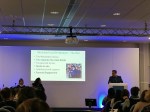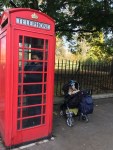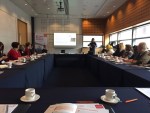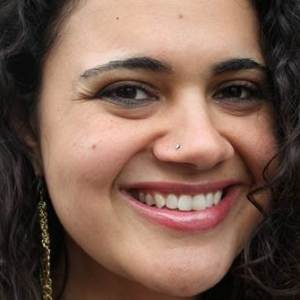
I have been blessed to attend many conferences over the course of my Ford W. Bell fellowship and have helped support many projects over the past year, however, none have been as comprehensive and accessible as the “My Primary School is at the Museum” project. In fact, I was so revitalized following this conference that I now champion all museum workers to attend more conferences in the United States and abroad. It is the best type of professional development that makes us feel not so alone in this often isolating and resource light work and it also allows us to see and experience what others are doing with little funds and lots of creativity and brain power.
Being able to present with the phenomenal team at the Museum Association was not only a privilege, it was inspirational. I learned so much from each of my co-presenters, I now see their work as a model for the field internationally. They shared not only their experiences of three museum “residencies”, they also shared real concrete reports, an online forum and resources, and step by step planning and tips (below) that will help take this idea from a great experiment into a real educational movement.

Part of what makes this movement so convincing is the vision of the program’s extraordinary leader, Wendy James, of Garbers & James architectural firm. James is a dynamic and genuine person whose passion for this topic is contagious. She sees this as an unquestionable good idea for museums and schools alike and it is refreshing to hear from someone outside of the field who just loves spaces and putting them to good use. As she says, “My work in the public cultural sector has increasingly specialized in education and museums. I strongly believe that there could be many creative benefits from children engaging with richly diverse object collections, for the pupils, their families, schools, and museums. I am delighted at the opportunity to rest such a partnership model between primary schools and their local museums and to develop the knowledge and understanding we need to shape what we hope will be the partnerships of the future.” Ms. James talked Mr. Russell Dwyer, the Head Teacher (Principal pictured speaking below) at St Thomas Community Primary School (Elementary School) into developing one of these museum/school partnerships and he presented at the conference with me.
Here are the “My Primary School is at the Museum” research team’s “Top Tips” from tried and true partnership experiments.
Skip over related stories to continue reading articleTOP TIPS for a successful school-museum residency
1) Plan for the life of the school: When planning, ensure you take into account the life of the whole school when designing extended school residencies, e.g. assemblies, school plays, lunch clubs etc.
2) Draw from the experience of others: There’s a wealth of best practice examples of teaching the whole or parts of the curriculum in museums and cultural organizations to a very high standard across the sector that can help inform planning—check out our blog for ideas: myschoolatthemuseum.site.
3) Think creatively about spaces: Museums have lots of existing spaces and it’s useful to think about their use really creatively when planning a school residency, don’t just use your usual school spaces. Child protection issues are particularly important to tackle early on in planning.
4) Evaluate!: Collecting robust evidence will help everyone involved learn as much as possible from the experience and show evidence of impact to advocate for future school residencies.
5) Training: Provide training in how to maximize cross-curricular learning, using not only the collection but also the physical building, behind-the-scenes storage, shop and café facilities and external spaces.
6) Develop bespoke resources for literacy skills: As well as improving children’s oral communication skills, extended residencies can develop their literacy skills.
7) Co-create educational experiences: With teachers and museum staff working collaboratively, extended residencies offer opportunities for deeper engagement and for involving children in co-creating learning experiences.
8) Engage all museum staff: From front of house and security to curatorial departments, all museum staff can play an important part in an extended residency. Training and briefings should be organized so that all staff are clear about their contribution and the value of such experiences for children.
9) Understanding: Extended residencies require both schools and museums to understand each other’s organizational cultures and ways of working. Regular meetings and briefings with museum and school staff are essential, both in the run-up to the residency and during it.
10) Explore the use of outdoor spaces: When planning a residency, staff should consider the most effective use of the museum’s external spaces in order to provide children with access to outdoor play and learning.
I hope this work continues to change minds and lives. I know the museum world is convinced of the positive impact of such programs, now we have our work ahead of us convincing more formal educators around the world.
Far too often, we leave conferences inspired but then have even more work on our desks when we return, so we need to make concrete commitments and follow through on them after conferences and other forms of professional development. What I will do with the inspiration I gained from My Primary School is at the Museum is to spread the word to all education policymakers I meet and both museum and formal education professionals who are looking for new ways of engaging students. I am committed to advocating for and producing tools that help more museum educators, teachers, parents, and students be transformed by these types of experiences.
It is remarkable what a change of scenery will do to all of us. I plan to ask everyone I meet who has anything to do with education one or two of the following questions:
- How about a museum residency?
- A field trip is nice but have you thought about a longer-term engagement over 2-8 weeks in a museum for in-depth multi-subject learning?
- We shouldn’t have to wait until college to have immersive learning experiences, why not start them out in Kindergarten like “My Primary School is at the Museum?”
- Are your students struggling with social-emotional life skills? Why not have their classes set in public so they can be more engaged?
About the project

My Primary School is at the Museum was conceived by architect Wendy James and developed in collaboration with the School of Education, Communication & Society, King’s College London with support from the Cultural Institute at King’s. The project was realized through partnerships with Arbeia Roman Fort & Museum and Hadrian Primary School in South Shields; Tate Liverpool and Life Bank Nursery at Kensington Children’s Centre in Liverpool; and the National Waterfront Museum and St Thomas Community Primary School in Swansea. It was evaluated by Heritage Insider Ltd.

Please check out this short article reviewing the experience from King’s College. And, here is the Storify of our experience (and a selected image on your left of the second presentation where these tools are being reviewed, with tea!).









Comments